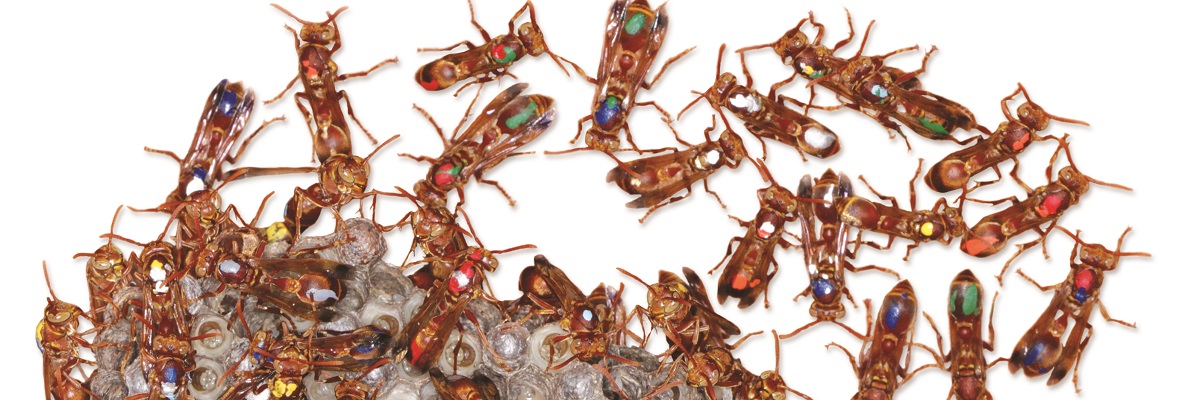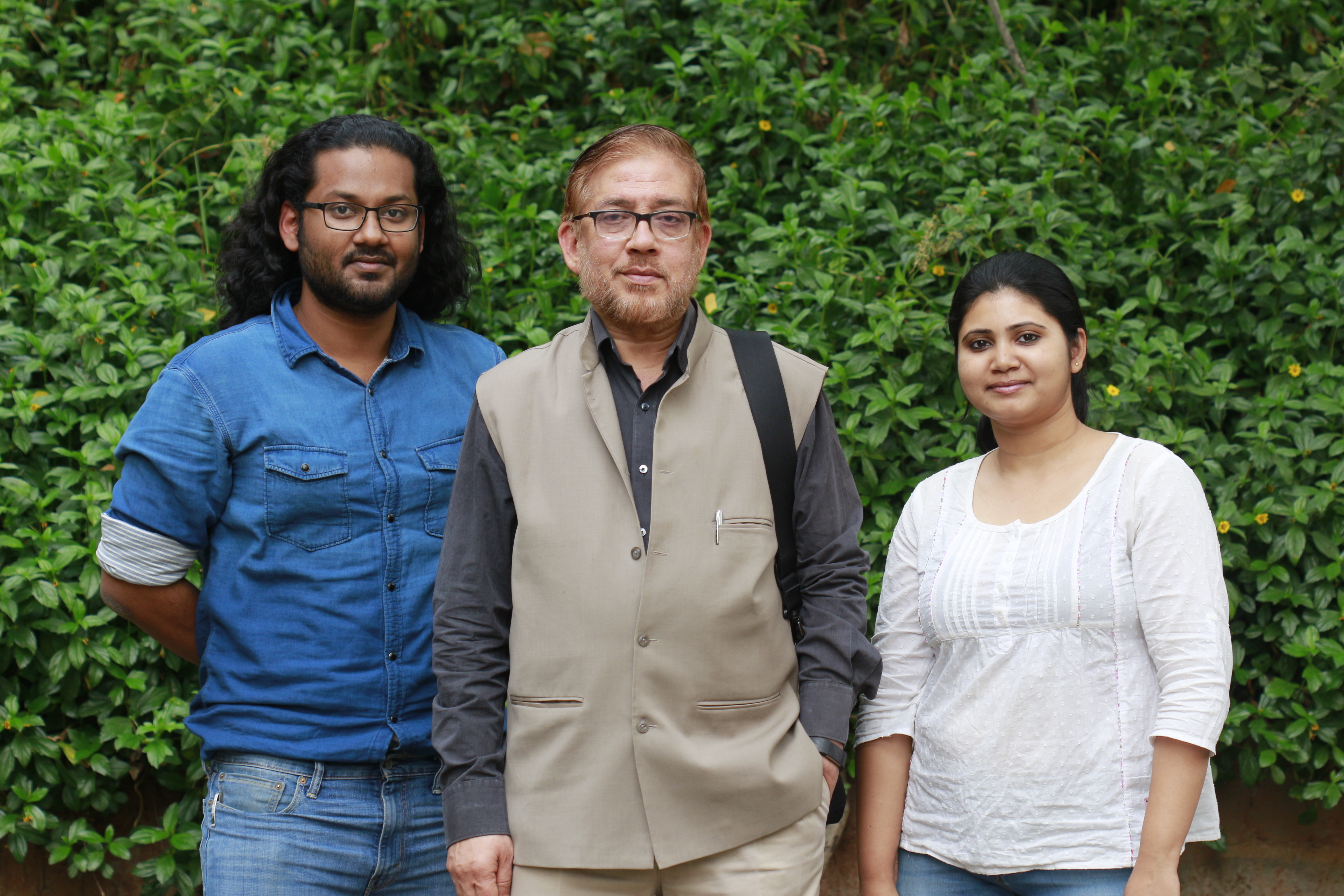Indian Paper Wasps Have the Best of Both Worlds!
 In insect societies such as those of ants, bees, wasps and termites, only one or a small number of individuals (queens and kings) reproduce, while the remaining (workers), function as sterile helpers, assisting the queens and kings to produce and rear large numbers of offspring. The evolution of such altruism by the workers appears paradoxical from the point of view of Darwinian natural selection. A well-known solution to this paradox is the theory that although workers may not get direct fitness because they don’t reproduce, they get indirect fitness because they assist in the survival and reproduction of close genetic relatives. What matters, the theory argues is Inclusive Fitness, the sum of the direct and indirect components. In an effort to test this theory, researchers have been busy trying to unravel the mechanisms of gaining indirect fitness, while the possibility that workers may also get some direct fitness has been all but neglected. We have therefore focussed on the ways by which workers of the Indian paper wasp Ropalidia marginata may also get direct fitness. One route by which they can do so is to leave their parental nests and found their own
In insect societies such as those of ants, bees, wasps and termites, only one or a small number of individuals (queens and kings) reproduce, while the remaining (workers), function as sterile helpers, assisting the queens and kings to produce and rear large numbers of offspring. The evolution of such altruism by the workers appears paradoxical from the point of view of Darwinian natural selection. A well-known solution to this paradox is the theory that although workers may not get direct fitness because they don’t reproduce, they get indirect fitness because they assist in the survival and reproduction of close genetic relatives. What matters, the theory argues is Inclusive Fitness, the sum of the direct and indirect components. In an effort to test this theory, researchers have been busy trying to unravel the mechanisms of gaining indirect fitness, while the possibility that workers may also get some direct fitness has been all but neglected. We have therefore focussed on the ways by which workers of the Indian paper wasp Ropalidia marginata may also get direct fitness. One route by which they can do so is to leave their parental nests and found their own  where they are free to reproduce. We recorded the ages and the behavioural profiles of all the workers in several naturally occurring colonies on the campus of the Indian Institute of Science, and then isolated each worker in a plastic box, simulating the conditions of nest foundation in nature. About 40% of the workers so isolated, successfully built their own nests and began to reproduce. As expected, we found that the probability that a worker founds a nest and lays eggs declined with her age and was positively correlated with her rate of feeding herself before isolation. Rather unexpectedly, we found that working hard on the parent nest did not significantly diminish her chances of future reproduction. We thus demonstrate that working towards direct fitness in the present is not incompatible with obtaining indirect fitness in the future. Such an ability to have the best of both worlds, should facilitate the evolution of worker altruism beyond what was hitherto suspected.
where they are free to reproduce. We recorded the ages and the behavioural profiles of all the workers in several naturally occurring colonies on the campus of the Indian Institute of Science, and then isolated each worker in a plastic box, simulating the conditions of nest foundation in nature. About 40% of the workers so isolated, successfully built their own nests and began to reproduce. As expected, we found that the probability that a worker founds a nest and lays eggs declined with her age and was positively correlated with her rate of feeding herself before isolation. Rather unexpectedly, we found that working hard on the parent nest did not significantly diminish her chances of future reproduction. We thus demonstrate that working towards direct fitness in the present is not incompatible with obtaining indirect fitness in the future. Such an ability to have the best of both worlds, should facilitate the evolution of worker altruism beyond what was hitherto suspected.
Brahma, A, Mandal, S and Gadagkar, R. 2018. Current indirect fitness and future direct fitness are not incompatible. Biol. Lett. 14:2. doi: 10.1098/rsbl.2017.0592.
Centre for Ecological Sciences; 13th February, 2018. http://ces.iisc.ernet.in/hpg/ragh/




 In insect societies such as those of ants, bees, wasps and termites, only one or a small number of individuals (queens and kings) reproduce, while the remaining (workers), function as sterile helpers, assisting the queens and kings to produce and rear large numbers of offspring. The evolution of such altruism by the workers appears paradoxical from the point of view of Darwinian natural selection. A well-known solution to this paradox is the theory that although workers may not get direct fitness because they don’t reproduce, they get indirect fitness because they assist in the survival and reproduction of close genetic relatives. What matters, the theory argues is Inclusive Fitness, the sum of the direct and indirect components. In an effort to test this theory, researchers have been busy trying to unravel the mechanisms of gaining indirect fitness, while the possibility that workers may also get some direct fitness has been all but neglected. We have therefore focussed on the ways by which workers of the Indian paper wasp Ropalidia marginata may also get direct fitness. One route by which they can do so is to leave their parental nests and found their own
In insect societies such as those of ants, bees, wasps and termites, only one or a small number of individuals (queens and kings) reproduce, while the remaining (workers), function as sterile helpers, assisting the queens and kings to produce and rear large numbers of offspring. The evolution of such altruism by the workers appears paradoxical from the point of view of Darwinian natural selection. A well-known solution to this paradox is the theory that although workers may not get direct fitness because they don’t reproduce, they get indirect fitness because they assist in the survival and reproduction of close genetic relatives. What matters, the theory argues is Inclusive Fitness, the sum of the direct and indirect components. In an effort to test this theory, researchers have been busy trying to unravel the mechanisms of gaining indirect fitness, while the possibility that workers may also get some direct fitness has been all but neglected. We have therefore focussed on the ways by which workers of the Indian paper wasp Ropalidia marginata may also get direct fitness. One route by which they can do so is to leave their parental nests and found their own  where they are free to reproduce. We recorded the ages and the behavioural profiles of all the workers in several naturally occurring colonies on the campus of the Indian Institute of Science, and then isolated each worker in a plastic box, simulating the conditions of nest foundation in nature. About 40% of the workers so isolated, successfully built their own nests and began to reproduce. As expected, we found that the probability that a worker founds a nest and lays eggs declined with her age and was positively correlated with her rate of feeding herself before isolation. Rather unexpectedly, we found that working hard on the parent nest did not significantly diminish her chances of future reproduction. We thus demonstrate that working towards direct fitness in the present is not incompatible with obtaining indirect fitness in the future. Such an ability to have the best of both worlds, should facilitate the evolution of worker altruism beyond what was hitherto suspected.
where they are free to reproduce. We recorded the ages and the behavioural profiles of all the workers in several naturally occurring colonies on the campus of the Indian Institute of Science, and then isolated each worker in a plastic box, simulating the conditions of nest foundation in nature. About 40% of the workers so isolated, successfully built their own nests and began to reproduce. As expected, we found that the probability that a worker founds a nest and lays eggs declined with her age and was positively correlated with her rate of feeding herself before isolation. Rather unexpectedly, we found that working hard on the parent nest did not significantly diminish her chances of future reproduction. We thus demonstrate that working towards direct fitness in the present is not incompatible with obtaining indirect fitness in the future. Such an ability to have the best of both worlds, should facilitate the evolution of worker altruism beyond what was hitherto suspected.